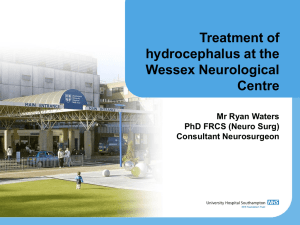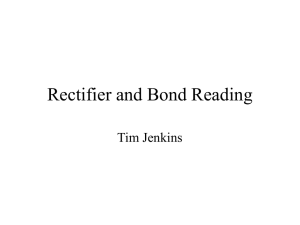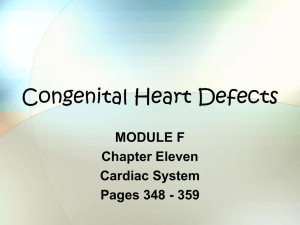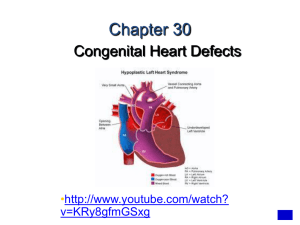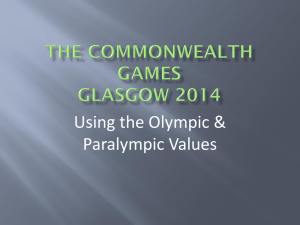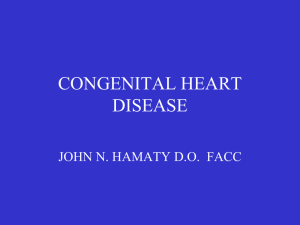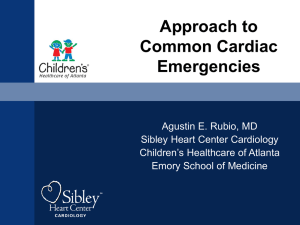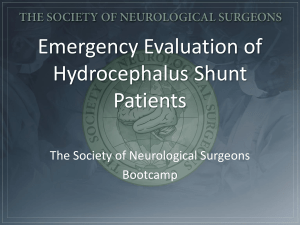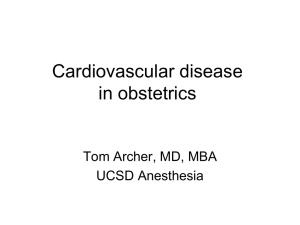cardiac surgery - Ain Shams University
advertisement
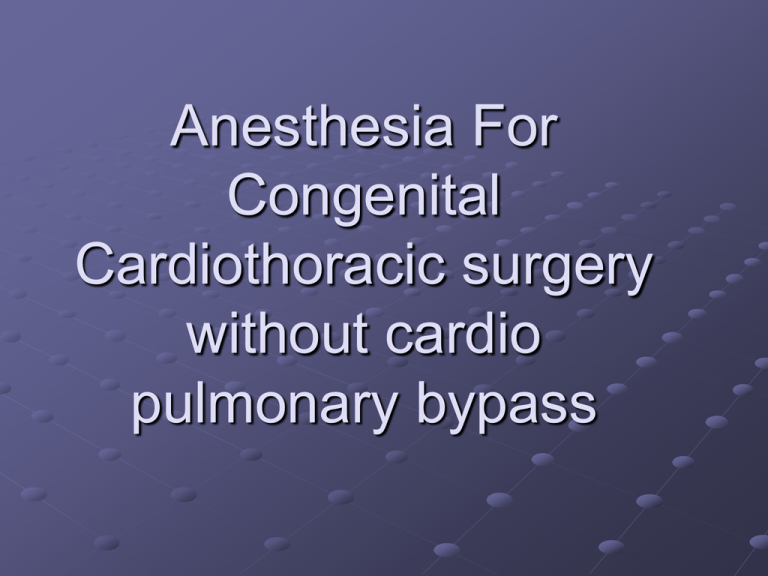
Anesthesia For Congenital Cardiothoracic surgery without cardio pulmonary bypass By Mohamed Abd el Moneim Fouly Resident of Anesthesiology Ain Shams university Hospitals Under supervision of Prof. Dr. Samia Sharaf Professor of Anesthesiology & intensive care Ain Shams University What are the surgical procedures ? Systemic pulmonary Arterial shunts. Systemic pulmonary venous shunts. Coarctation of the aorta. PDA ligation General principles in Anesthetic management. Preoperative Assessment : Should be complete with special attention to history taking & the developmental milestones of the patients , both motor & cognitive status, With a full lab work up, CXR & and echocardiography. N.B. Coronary angiography is not mandatory but may be needed in some cases Intra operative management Monitoring : basic for all cases with some modifications in some cases. Pulse Oximetry. 12 Lead ECG ( we use only 5) Invasive arterial blood pressure monitoring , also used for frequent ABGs Sampling. Trans esophageal echo is also used as a monitor to cardiac functions. Swan Ganz catheter may be used. Induction of Anesthesia In halational induction with Sevoflurane has always been the best choice , others as Halothane are less favored due to dramatic effect on the haemodynamics. I.V. induction in cases with available venous access is also good with less effect on haemodynamics using either ketamine & or Fentanyl in critically ill patients with little effect on haemodynamics so it is suitable for preterm infants & those with heart failure. Induction of Anesthesia I.M. Induction with ketamine 5 mg/kg is of choice but may precipitate a cyanotic spell in infants with Fallot tetralogy. Systemic pulmonary Arterial shunts Indications: Palliative surgery for TOF. Aim: Increasing pulmonary blood flow. Types: Central shunt: artificial tube graft between the aorta & the pulmonary artery. Blalock Tausssig shunt: anastmosis of the right or left subclavian arteries to the ipsilateral PA. MBT shunt: artificial tube graft between the right or the left PA & their adjacent Subclavian artery. MBT SHUNT Most of the patients are critically ill due to decreased pulmonary blood flow. Anesthetic management: Preoperative: Mechanical ventilation to improve oxygenation & PGE2 infusion to prevent closure of the DA may be of help. Monitoring : basic with care for radial artery cannulation in the side opposite to that of shunt placement as this might lead to steal pressure giving false low readings. MBT SHUNT Central venous cannulation. Femoral artery cannulation with care for lower limb ischemia. Induction: I.V. Ketamine 1mg/kg+ Fentanyl + MR . Inhalational with SEVO is the best. I.M. ketamine 5mg/kg for unstable patients is the last choice. MBT SHUNT Intra operative management The myocardial depressant effect of the volatile agents is also useful in limiting the infundibular spasm. Care to maintain SVR in order to limit Right to left shunt through the VSD so SEVO is the best Low SVR is treated with phenyl ephrine or nor epinephrine & preload augmentation with fluid boluses. MBT SHUNT Intra operative management All inotropes will worsen the infundibular spasm by increasing HR & contractility. Classically it is placed through thoracotomy Median sternotomy is done if: Patient can't tolerate lung retraction or side clamping of the pulmonary artery. Possibility of CPB or central shunts. MBT SHUNT Intra operative management Low dose heparin 100 IU/Kg prior to shunt placement. Lung retraction may severely impair oxygenation & ventilation so intermittent reinflation may be required. Also side clamping of the PA may lead to the same which is managed by fluid , vasopressors & ventilation adjustment. MBT SHUNT Intra operative management Attempting to normalize PCO2 during one lung ventilation may lead to over inflation of the dependant lung & thus increasing PVR & impairing venous return. For central shunts partial clamping of the ascending aorta may be required but it may be poorly tolerated in this case inotropic support with dopamine may be helpful. MBT SHUNT Intra operative management Once the shunt is opened O2 saturation markedly improves however blood pressure may drop which may be treated with vasopressors & volume infusion. Decrease in Diastolic BP may lead to decrease in coronary blood flow which in turn may lead to ischemic ECG changes. MBT SHUNT Intra operative management Ventilation & inspired O2 is adjusted to mimic spontaneous non anesthetized patients for accurate assessment of shunt flow. O2 saturation of 80% is optimum indicating balanced pulmonary & systemic blood flow. High O2 saturation indicates pulmonary over circulation & the shunt size may have to be reduced & Vice versa. MBT SHUNT Intra operative management In cases of persistence of hypoxemia after apparently uneventful shunt placement it is important to rule out endobronchial intubation because failure to do so may lead to unnecessary shunt revision or even sternotomy. MBT SHUNT Post operative management Ventilation for 12 – 24 hours. Checking the patency of the shunt by auscultating a continuous murmur on the endotracheal tube. Low dose heparin at 8 – 10 U/Kg/min to maintain patency of the shunt after diminishing the risk of postoperative bleeding. MBT SHUNT Complications Increased PBF may lead to pulmonary edema & hemorrhage. Injury to phrenic or recurrent Laryngeal nerve. Injury of sympathetic chain. Chylothorax or shunt thrombosis. Systemic pulmonary Venous shunts Glenn shunt Indications: TO bypass the right side of the heart as in pulmonary or tricuspid atresia. Aim: Increasing pulmonary blood flow. Procedure: surgical anastmosis between SVC & Right pulmonary artery. It may be a 1st stage of a 2 stage management ( the second is called Fontan operation). Glenn Shunt It may be of two types either (side to end) or ( side to side) the later is called a bidirectional Glenn. GLENN SHUNT Intra operative management Monitoring : as usual Induction : inhalational induction in these patients is less convenient due to decreased pulmonary blood flow. Vascular access: A single lumen IJV central venous catheter which is not used for infusions. GLENN SHUNT Intra operative management All wide bore I.V. access should be placed in the lower half of the body. Central venous catheter is inserted in the femoral vein which is used for transfusion & infusion of drugs. Arterial cannulation either radial or femoral. GLENN SHUNT Intra operative management Inotropic support might be needed ; adrenaline, dobutamine, or phenylephrine Also vasodilators might be needed as nitroglycerine or nitroprusside. GLENN SHUNT Intra operative management Immediately after the shunt is opened use the IJV catheter to measure the Pulmonary blood pressure. In some cases excessive shunting may lead to pulmonary edema. In other cases symptoms & signs of systemic venous congestion e.g. edema & puffiness of the face & the eye lids & edema of the upper ½ of the body. GLENN SHUNT Intra operative management In case of the need to infuse large volume use the wide bore I.V access in the lower ½ of the body as any infusion in the upper ½ will be a direct infusion in the pulmonary circulation & may lead to pulmonary edema. GLENN SHUNT Post operative management Post operative ventilation for 24 – 48 hours for fear of pulmonary edema. Pulmonary vasodilator is mandatory oral , sublingual or I.V sildenafil is a very potent pulmonary vasodilator. Coarctation of the aorta Characterized by narrowing of the aortic lumen opposite to the ductus arteriosus & just distal tot the opening of the left subclavian artery. 8 % of all cardiac patients may have associated coarctation. Incidence Male : Female = 3:1 Coarctation of the aorta If not treated early collaterals will develop. Types of surgical interventions: Subclavian flap aortoplasty Resection anastmosis either end to end or end to side. Tube graft interpositioning. Coarctation of the aorta Preoperative management Inotropic support & diuretics If the age is less than 1 month I.V prostaglandins to prevent closure of the ductus arteriosus.. Elective intubation & ventilation to decrease work of breathing & decrease left ventricular demand. Coarctation of the aorta Preoperative management Correction of metabolic acidosis to improve left ventricular function. Right sided arterial cannulation in to a preductal artery is mandatory. Intraoperative management: Intra arterial catheter to ensure monitoring of the blood pressure during phases of the operation when the left subclavian artery or the aorta is clamped or compressed. Coarctation of the aorta Intraoperative management Cool the child to 35 C to avoid spinal cord ischemia. I.V. or inhalational induction. Avoid hypertension due to exaggerated response to inotropes. Application of cross clamp may lead to upper body hypertension. Coarctation of the aorta Intraoperative management Blood flow to the lower ½ of the body & the spinal cord is highly dependant on collaterals that can vary depending on the systolic pressure generated by the myocardium. It is possible that the failing ventricle may be unable to mount appropriate arterial blood pressure in which case dopamine or other inotropic agent is administered. Coarctation of the aorta Postoperative management Early post operative complication is hypertension for 2 weeks which is explained by secondary stimulation of the sympathetic system distal to anastmotic site, if it was untreated it may lead to mesenteric arteritis. So it must be treated with vasodilators , calcium channel blockers & or B- blockers. Patent Ductus Arteriosus Standard monitoring with pulse oximetry of the four limbs to detect incidental ligation of the descending aorta. Large venous access. Forced air warming devices. High spinal & epidural has always been safe Patent Ductus Arteriosus In neonates I.V. anesthetics are better & more stable on the hemodynamics, than inhalational anesthetics e.g. fentanyl & benzodiazepines with muscle relaxants. Lung isolation may improve surgical exposure but may require ventilation with 100 % O2 to maintain adequate oxygenation. Patent Ductus Arteriosus Prior to lung isolation , efforts should be made to limit left to right shunt by maintaining or improving pulmonary vascular tone : minimize FiO2 & maintain PaCO2 between 40 – 50 mmHg. Avoid air bubbles in the I.V. lines to decrease the risk of paradoxical air embolism. Patent Ductus Arteriosus Critically ill patients may require high doses of narcotics to minimize stress response to surgery. Lung isolation is needed for VAS to allow adequate exposure. Thank You
